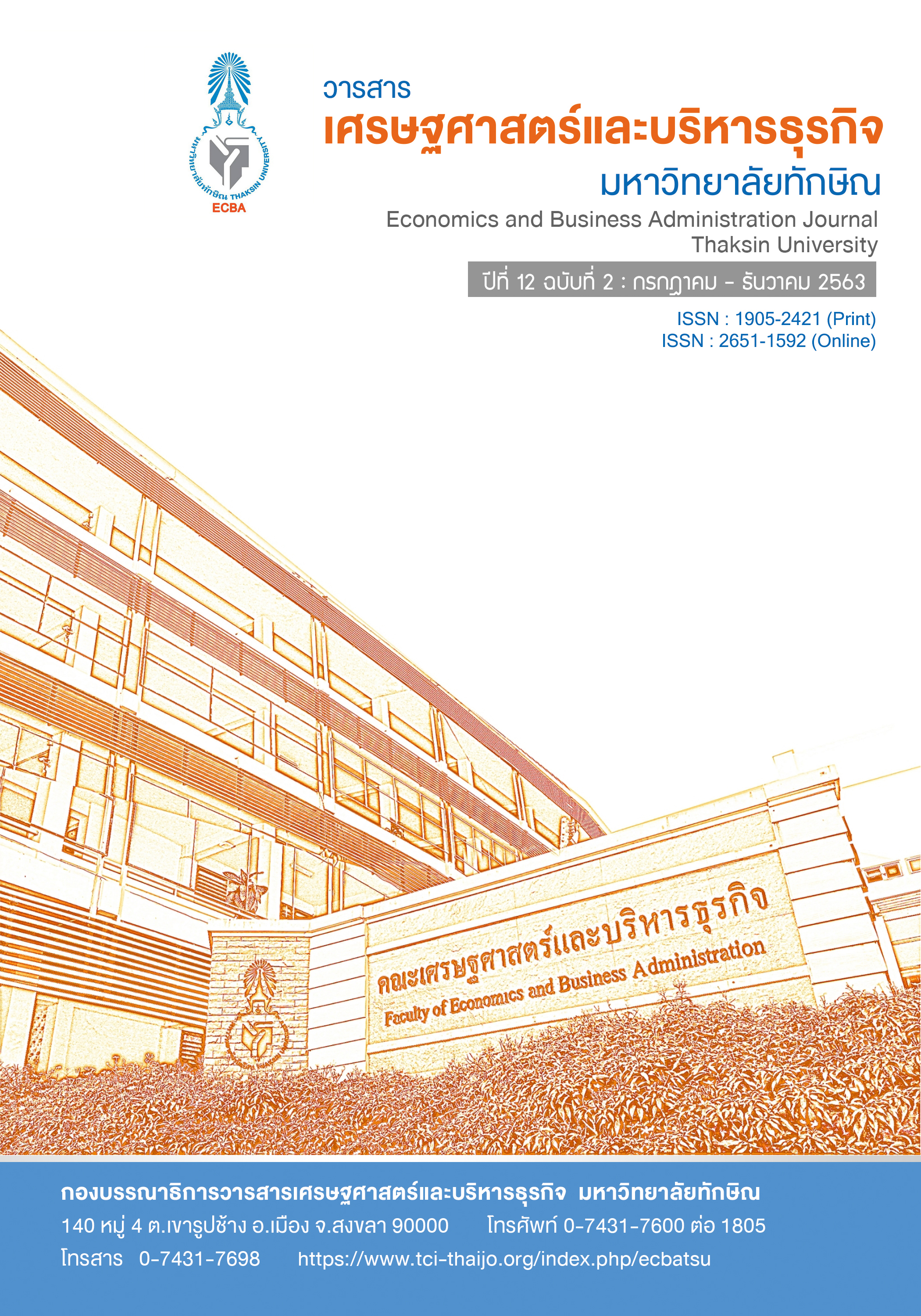Factor Analysis of Competitive Advantage of Small and Medium Enterprises in Songkhla
Keywords:
Competitive Advantage, Private Businesses, Factor AnalysisAbstract
This research aimed to study the confirmatory factor analysis of competitive advantage of private businesses and to examine the consistency of the relationship model developed with an empirical data.The sample consisted of 396 entrepreneurs with the purposive sampling method. Data collected by questionnaires and statistical program used to analyze the data. The results found that the model analysis of the second confirmatory factor of the competitive advantage of private businesses of four components such as innovation, quality, customer responsiveness, and efficiency included goodness of fit with the empirical data X2 = 280.714, df = 145, X2/df = 1.936, p-value = 0.053, GFI = 0.932, CFI = 0.967, RMR = 0.046, and RMSEA = 0.049. The competitive advantage of private businesses on four components were found from the high to low value as innovationat 0.99, quality at 0.93, customer responsiveness at 0.91, and efficiency at 0.77, respectively. Therefore, entrepreneurs should focus on the development of operational capabilities within the organization, to increase the competitive advantage to keep pace with the changing economic conditions at present.
References
Bentler, P. M. & Bonett, D. G. (1980). Significance tests and goodness-of-fit in the analysis of covariance structures. Psychological Bulletin. 88, 588-600.
Byrne, B.M. (2005). Factor analytic models: Viewing structure of an assessment instrument from three different perspectives. Journal of Personality Assessment. 85, 17-32.
Chaengploy, W. & Jadesalug, V. (2016). Competitive advantage strategy in coffee shop business of retail entrepreneurs in Muaeng district, Ratchaburi province, Veridian E-Journal, Silpakorn University, 9(3), 1331-1349.
Chaihathep, A. & Chapavang, K. (2016). Effects of logistic efficiency management’s strategy on competitive advantage of the food industry in Thailand. Journal of Accountancy and Management, 8(3), 170-179.
Chatreewisit, R., Pujinda, S., Chutrakul, A., Jinanurak, N., Pluangkrasae, P. & Ninju, V. (2010). Strategic management. (2nd ed.). Bangkok: Thungsab Publisher.
Danthumrongkul, W. (2006). The heart of service to success. Bangkok : SE-EDUCATION.
Decharin, P. (2003). Implementing balanced scorecard. (2nd ed.). Bangkok : Chulalongkorn University Press.
Department of Labor Protection and Welfare. (2014). The number of businesses Songkhla province. Retrieved from http://eservice.labour.go.th/dlpwMapWeb/map/
Fornell, C. & Larcher, D. (1981). Evaluating structural equation models with unobservable variables and measurement error. Journal of Marketing Research.18(3), 39-50.
Fuller, T. (2004). Corporate ethical futures responsibility for the shadow on the future of today’s ethical corporations. New York: John Wiley & Sons.
Hair, Jr.J.F., Black, W.C., Babin, B.J. & Anderson, R.E. (2010). Multivariate data analysis: A global perspective ( 7th ed.). New York: Pearson Prentice Hall, Harper Collins College.
Katemanee, P., Lalitsasivimol, W., Thongpoon, S. & Jankingthong, K. (2018). Competitive advantage of SMEs in Thailand 4.0, Journal of the Humanities and Social Sciences Mahasarakam, 37(4), 245-256.
Matchuang, O. (2014). The relationship between human capital management and competitive advantage of small and medium enterprises in northeast Thailand. Journal of the Humanities and Social Sciences Mahasarakam. 34(4) : 214-222.
Naweekarn, S. (2005). Strategic management and business policy. Bangkok : Bhannakij Press.
Nawikana, S. (2005). Strategic management and business policy. Bangkok: Bhannakij.
Nonthnathorn, P. (2010). Corporate social responsibility management: Creating sustainable competitive advantage. Bangkok: Thinkbeyond Book.
Office of Small and Medium Enterprises Promotion. (2014). Promoting SMEs plan. Retieved from www.sme.go.th/Pages/aboutSMEs/art_4.aspx.
Robbins, S.P. (2005). Essential of organizational behavior. 8th ed. U.S.A: Pearson Education, Inc.
Sanguanwongwan, W. (2010). Management. Bangkok: Pearson Education Indochaina Co., Ltd.
Santiwong, T. (2008). Personnel management. (13th ed.). Bangkok : Thaiwattanapanit.
Saritvanit, S. (2010). Strategic management: Concept and theory. Bangkok: Thammasat University.
Sattakom, T., Jaranakaran, S., & Sakonkaruehadet, K. (2018). The Effect of dynamic competitive advantage and business partnership strategy on SMEs success in Chainat province: The case of accomodation and restaurants business. The Journal of Business Administration and Languages, 6(2), 58-62.
Siksamat, S. (2012). Effects of minimum wage increase 300 Baht : Implementing general equilibrium model. Bangkok : Bank of Thailand.
Siri, P. (2014). The key success factors of small and medium enterprises (SMEs) entrepreneurs in Songkhla province. SKRU Academic Journal, 7(2), 53-64.
Siriniran, S. & Saichu, P. (2009). Corporate policy: Source and method of implementation. Bangkok: Odeon Store.
Sukprasert, S., Prachsriphum, S. & Tantiset, N. (2014). Effects of modern executive characteristics on operational success of accounting firms in Bangkok. Journal of the Humanities and Social Sciences Mahasarakam, 33(3), 191-199.
Thonglo, J., Raksong, S. & Erawan, T. (2014). Effect of competitive advantage building orientation on operational success of garment manufacturing businesses in Thailand. Journal of the Humanities and Social Sciences Mahasarakam. 33(1), 36-44.
Ukenna, S.I., N.A. Carol. & M.C. Olise. (2010). Effect of investment in human capital development on organizational performance: Empirical examination of the perception of small business owners in Nigeria. European Journal of Economics, Finance and Administrative Sciences, 26(11), 93-107.
Vanichbuncha, K. (2007). Statistics analysis : Statistics for administration and research. (10th ed.). Bangkok : Chulalongkorn University Press.




